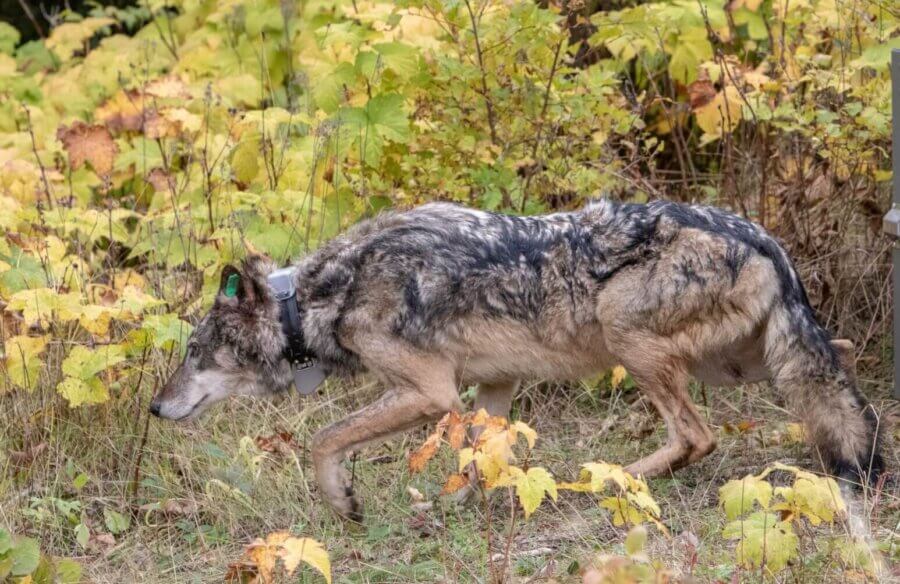
It’s one of Michigan’s most tucked-away and pristine natural gems. And it’s also famous worldwide for the unique predator-prey relationship that exists among wolves and moose.
Not long ago, I made and posted this meme about Isle Royale—a certain oversimplification of one of Michigan’s most tucked-away and pristine natural gems:
Isle Royale is, of course, most famous for three things: being located in Lake Superior (the Michigan side), having no permanent residents, and being home to wolves and moose that really do duke it out.
Who wouldn’t want to know more?
I did some research and quickly found out that it wasn’t always this way—well, at least not the whole wolves and moose battleground.
Even more intriguing: This isolated wolf-moose relationship is unique on a global scale, and it is studied worldwide to learn about how predators and prey interact.

The Basics
Isle Royale, at roughly 45 miles long and nine miles wide, is the largest island in Lake Superior. It’s also the fourth-largest lake island in the world, and—along with more than 400 small islands around it—makes up Isle Royale National Park. It’s a UNESCO International Biosphere Reserve and borders the Canadian Lake Superior National Marine Conservation Area.
Isle Royale itself has lakes—cold, clear ones, like the normal-sounding Sargent Lake, and the not-normal-sounding Chicken Bone Lake. In those lakes are other islands.
Despite its many qualities, Isle Royale is the seventh least-visited national park in the United States. Being a remote island might have a little something to do with that.
The Early Years
Isle Royale is not believed to be the site of any early Indigenous settlements, but for thousands of years, the copper-rich island was a popular hunting, fishing, and mining ground for native tribes, who would travel there by canoe over the summer. After the US government formally acquired the land in 1842, fishermen, and geologists used the island in similar ways.
Notably absent around this time were moose and wolves. For 3,500 years, caribou and lynx were the two large mammals present on Isle Royale. As humans arrived in greater numbers, neither species could survive the hunting or the loss of their habitat and food source, and they died out.
And then came the moose.

It’s a 13 mile swim or ice skate from the mainland, and first to make it in the early 1900s were the moose. The coyote, too, came for the rabbits and small foxes, but it was the moose who—unchecked by other large predators—flourished on Isle Royale for many years.
Imagine looking at the island from an aerial view at the time. So many moose roamed and swam and ate that, eventually, they outgrew their food source—as there wasn’t other competition for it.
A pattern of unchecked moose dominance over the land, and continuously dwindling food continued until the exceptionally cold winter of 1948 heading into 1949. That’s when company came over.

The Wolfpack
In the late 1940s, crossing over from Ontario on an ice bridge, a daring but small pack of wolves—possibly just a couple—quickly set their paws down as top canids on the island. By 1955, they had hunted and eradicated all of the coyotes. They also feasted on beavers and rabbits, but their favorite food source quickly became the calves of bull moose.
It was around this time that wolf populations in North America were plummeting. Nearing extinction from human hunting and settlement, it seemed like time was well and truly running out for the species. In Michigan, pack numbers would continue to plummet until the 1980s. So quickly did the population dwindle, that it became difficult for researchers to learn how to help save them.
And then they noticed Isle Royale. In 1958, the longest continuous study of any predator-prey system in the world began.

The apex predators had an abundance of food on the island. And the vegetarian moose had been starving more and more with each passing winter.
At the start of the study, there were around 20 wolves and 500 moose. Ten years later?

The moose population was 1,500 in 1968.
Nature’s Beauty and Brutality
Whether predator or prey, life on Isle Royale has never been easy.
In the 1980s, a disease introduced to the island by humans killed off much of the wolf pack, driving their numbers from 50 down to 14.
The wolves also struggled as a result of inbreeding. Their largely shared gene pool has led to fewer viable pups and harder-hitting diseases—unlike the moose population, which is more genetically diverse. The moose were winning.
But in 1997, a lone wolf from Canada crossed the ice bridge and established his position as new alpha on Isle Royale. Nicknamed “Old Gray Guy,” he was more territorial than the others on the island, and his pack grew larger than others in the past. By 2009, 56% of all wolves on Isle Royale were his descendants. With an influx of new genes to the pool, reproduction rebounded.
Then, a series of hot summers took its toll on the moose. Tired from ticks and expending more energy due to the heat and the wolves, the moose population struggled to survive the following winters.
And so it continued. A few seemingly minor tweaks to the conditions on Isle Royale left one species on the brink.
In 2012, three wolves fell into an abandoned mine shaft and died of their injuries. The loss of the female and two males delivered a crippling blow to the wolves they left behind.
In 2015, the beaver-built dam around Ojibwe Lake broke, and the water table quickly fell. Moose that had relied on plants in the lake for 50 years struggled to adapt—and several got trapped in the mud pits that surfaced. Beavers, who’d long used the dam as a refuge from preying wolves, also became easy food for the pack.
The pack, though, was down to two: a father and his daughter (as well as his half-sister, as they shared the same mother). The gene pool was so intertwined that pups were no longer viable.
Intervention
In 2018, the National Park Service decided to intervene. They introduced a small pack of wolves—in fact, a pack that year, and two others in 2019, captured from Canada, Minnesota, and Michigan—to Isle Royale.

Though the move went against their compass of allowing nature to take its course, the decision was made based on the inevitability that the wolves were all but finished on the island. Part of the rationale was that humans bore some blame for the decline of wolves on Isle Royale, by introducing disease and accelerating climate change—the latter of which limited ice bridges that could have allowed more wolves to cross over.
The introduction first met several challenges. In the first two years, eight wolves died—four of those through conflict with other wolves.
But in the time since, new pups have come along. In 2020, there were an estimated 12-14 wolves, and in February 2022, there were 28. They’ve split into an eastern pack and a western pack, and for the first time in five decades, moose are more abundant in the middle of the island than on just one end.
For their part, the moose are losing numbers at a rate that seems healthy, given the increasing size of the wolf packs. In 2022, there were an estimated 1,346 moose—28% fewer than in 2020. Researchers have concluded that the “predation rate”—the proportion of the moose population killed by wolves—is now 8.9%. The predation rate prior to the wolves’ population collapse was 9.9%. They’re working it out.
Despite the Park Service’s intervention, nature is still in charge. The effects from severe tick infestations are now killing a significant number of moose, and Isle Royale could once again be plagued by disease more than predation.
Whatever happens, humans will understand it a little better than before. In 2019, a new project began involving GPS. By 2022, 64 moose—primarily mothers and calves—were outfitted with GPS collars, which record each moose’s location, activity levels, and ambient temperature. Likewise, several wolves have also been collared.

In the long run, an equilibrium of the two populations would be beneficial for both species, scientists say. Whatever happens, the moose and wolves on Isle Royale have provided 65 years of research that’s simply impossible to do anywhere else.
It’s also given generations of interested onlookers stories to pass down, enriching the oral history and scientific history of the state of Michigan. And as much as they’ve been observed by us, the wolves and moose forced us to look at our own species, too. What are the impacts of our actions on the climate, on the lakes, and on the wildlife around us? What part in the ecological balance are we playing?
As we bend toward the seventh decade of study on Isle Royale, we have learned much, and what’s one for certain is the lives of the wolves, the moose, and the humans around them are inevitably and inextricably interconnected.
Author’s note: Big shoutout to the Historical Society of Michigan and its History Hounds series, which helped with my research. Also thanks to Dr. Rolf Peterson, a Michigan Tech professor who’s been leading the wolf-moose study on Isle Royale since the 1970s.

VIDEO: Trump isn’t the only republican facing charges for alleged financial crimes
https://www.tiktok.com/@gandernewsroom/video/7361494909938978090 A whole lot of Michigan Republicans and lobbyists are facing criminal charges for...

VIDEO: It’s expensive to be poor in Michigan
https://www.tiktok.com/@gandernewsroom/video/7361154790300060974 Ever heard of predatory payday loans? Here’s how new laws could help protect...

Here’s everything you need to know about this month’s Mercury retrograde
Does everything in your life feel a little more chaotic than usual? Or do you feel like misunderstandings are cropping up more frequently than they...

The ’Gander wins multiple 2023 Michigan Press Association awards
MICHIGAN—The ’Gander Newsroom has earned multiple awards in the 2023 Michigan Press Association Better Newspaper Contest. The awards were announced...

Michigan Republicans ask Supreme Court to restrict medication abortion access
A lawsuit supported by Republicans could disrupt access to the most common form of abortion—even in Michigan, where reproductive rights are...




